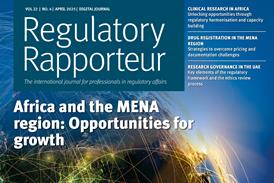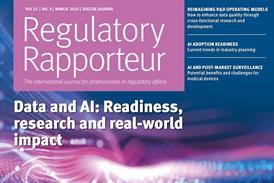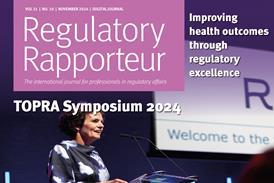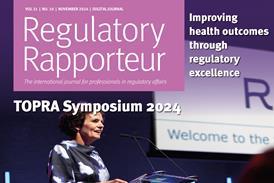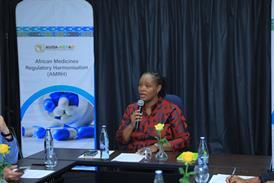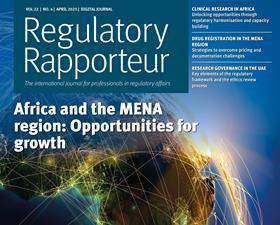
Regulatory Rapporteur
April 2025 | Volume 22 | No. 4
Welcome to April’s issue of Regulatory Rapporteur which focuses on Africa and the Middle East and North Africa (MENA) region.
This vast area of the globe encompasses 71 countries and, with a population of approximately 1.7 billion people, represents a multitude of languages, cultures, economies and demographics. The fact that there is such a diversity of approaches and processes to drug registration, bringing many challenges to approval and regulation, should therefore not be a surprise to us.

There has, however, been recent and positive progress to reduce these challenges. In a groundbreaking development for Africa’s public health sector, the African Medicines Regulatory Harmonisation (AMRH) Initiative has, in March 2025, successfully assessed and listed five medicines under the Continental Procedure for Evaluation and Listing of Human Medicinal Products.
The use of the Continental Procedure was implemented as a pilot in November 2023 to streamline the regulatory approval process amongst the 55 African Union (AU) member states and support the operationalisation of the African Medicines Agency (AMA). With technical support from the European Medicines Agency (EMA) and the World Health Organisation (WHO) and partners, the first ever joint evaluations under this procedure demonstrate Africa’s ability to conduct high-quality scientific reviews and facilitate a highly collaborative and harmonised registration process. As part of this initiative, a registry of Continentally Listed Products known as the ‘Green Book’ will provide publicly accessible information on approved medicines.
We are privileged to publish four ‘Focus’ articles for readers this month; two of which centre on the specific countries of Morocco and the United Arab Emirates (UAE), and two which focus on the MENA region and the African continent more generally. We hope you find them interesting and informative.
Africa presents many opportunities for global pharmaceutical companies and research institutions who are willing to conduct clinical trials there. However, at present, only 3% of clinical trials are run in African countries. Our first article, by Yvette Goedhart and Heba Hashem of PPD, part of Thermo Fisher Scientific, explores the evolving regulatory landscape which is essential to understanding the requirements to conduct research on this continent, discussing both the challenges faced and opportunities for growth.
Our second article, by Hicham El Horr, Mohamed Yafout, Youssef Khayati and Sanae Derfoufi of the University of Casablanca, takes a deep dive into the drug pricing mechanisms in Morocco, and their role in the drug registration process. After 2013, a new drug pricing system was introduced, based on external drug referencing (ERP), which is a commonly used model in regulated pharmaceutical markets. A brief history of drug pricing is discussed, followed by an analysis of the effects of Morocco’s evolving pricing mechanisms and the specific features of its reimbursement policy. This is an essential read for those involved in pricing and reimbursement in this country.
The Middle East and North Africa offer exceptional opportunities for innovation and growth. However, an understanding of the regulatory environment is crucial for companies entering into the region. Countries such as the UAE, Saudi Arabia, Egypt, Morocco, Jordan, Algeria, Tunisia and Libya have distinct regulatory frameworks governing pharmaceutical registration and pricing. Our third article, by Sukesh Bhardwaj, Sri Pranavi Bolla, Vishal Jain, Kirti Yadav, Vivek Tomar and Allison Gillespie at Syneos Health, provides a comprehensive description of the main hurdles to drug registration including pricing, dossier requirements and other local requirements. Within the MENA region, countries require extensive ancillary documents which must be included in the marketing authorisation application and subsequent variations as part of drug lifecycle management. These requirements are specifically reviewed, especially for documents such as Good Manufacturing Process certificates and Certificates of Pharmaceutical Product.
Our last ‘Focus’ article, by Dr Marie Ibrahim, Associate Director of Regulatory Affairs, IROS CRO, discusses the regulatory governance for medical research in the UAE. Within the MENA region, the UAE has positioned itself as a leader in research governance and regulatory affairs. The article includes a detailed review of the research regulatory framework while highlighting the role of individual authorities within the UAE’s jurisdiction. The UAE continues to refine its governance to support innovative and ethical research and this article gives an interesting and comprehensive overview of its requirements and applicable legislation, both at federal and local levels.
Looking at other topics, in our fifth article this month, Dr Nisha Vempalle, a global MedTech expert, gives a great overview of the essential steps required for Notified Body applications for medical devices and in vitro diagnostic products.
Our final article is a must-read for those interested in diversifying their careers, potentially moving from regulatory affairs into other areas across the pharmaceutical industry. Helen Donnelly, Senior Director, Commercial Operations, Mundipharma, UK, gives personal reflections on her move into management and commercial functions and provides insights into the transferrable skills gained from her regulatory affairs roles, which made her transition across the industry less daunting.


